Top teamwork capabilities in Microsoft Teams
Let's say you work for a new product startup team at Contoso Electronics. The product is the company's new flagship, the X1050. Since there are multiple people involved, you need a place where you can share and edit content. That's when Teams comes into action, providing a hub for teamwork every day. It has many built-in features to support the X1050 implementation team, including:
- With instant messaging and audio/video chats, you can communicate informally
- Everyone can attend live meetings, but they can also be recorded to be on the safe side
- Integration with other Microsoft 365 apps like Planner and other third-party apps
- Mobile app to stay with your team on the go
Sharing, channels and chat
At the beginning of the workday, open Teams and search for your favorite channels:
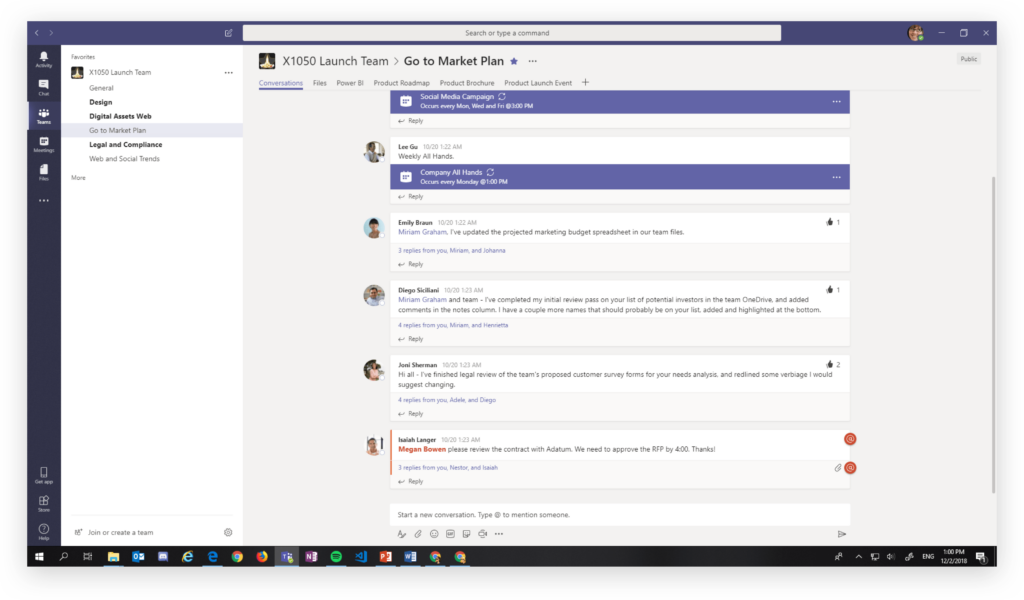
Channels focus conversations on a topic and cover every detail, in this case the X1050 launch plan. Emily, your manager, gave you the honor of creating a presentation of this plan. You've already put together the first version of your presentation in OneDrive with the help of your colleague Joni, but now she's ready to show it to others. There are several ways to share files in a Teams group.
Method 1: Directly in the group conversation, you can upload a copy of the presentation by clicking on the paperclip icon. However, I do not recommend this solution, because this way there will already be two pieces of the presentation, and it will be difficult to keep track of the changes later.
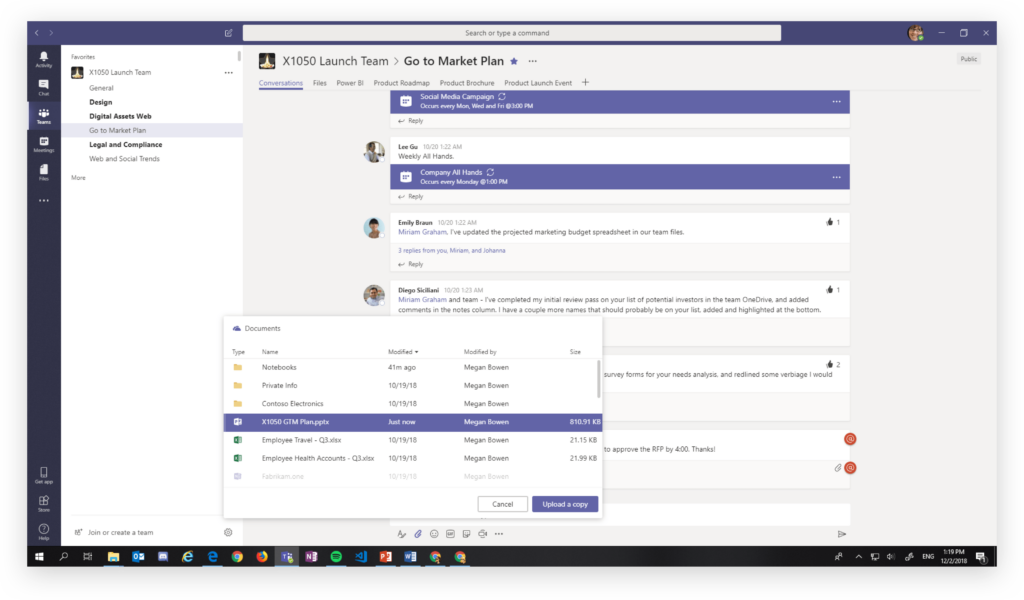
Method 2: You can move the file directly from OneDrive to Teams. I think this is the best option, as it does not create unnecessary copies of the file.

After sharing, the next task with the presentation is to co-edit with your teammates. In the go-to-market channel, go to the Files tab right-click on the presentation (or the 3 dots at the end of the line), and select "Make this tab".
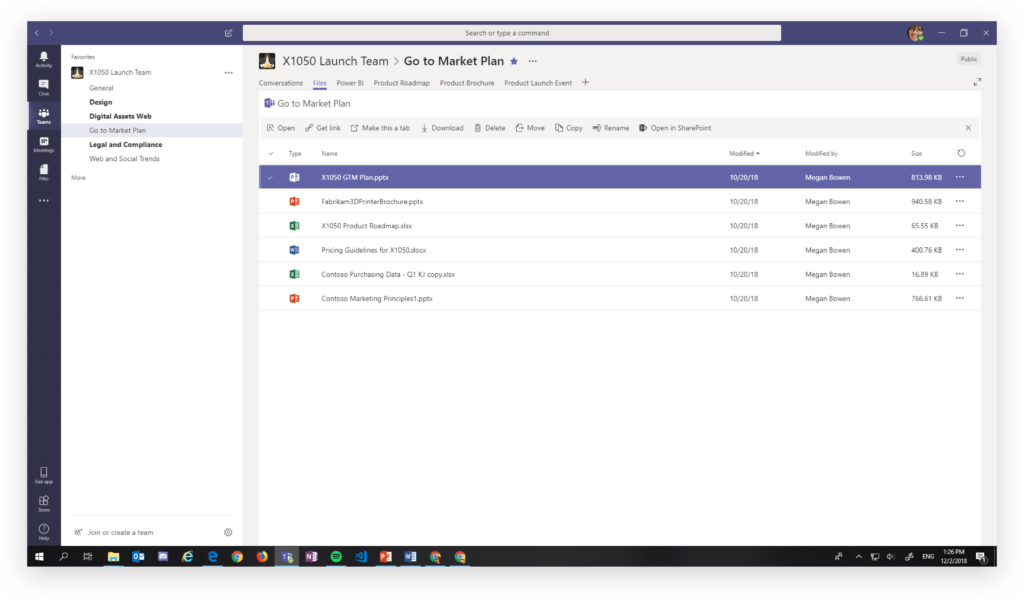
The newly created tab will be immediately visible to all team members.
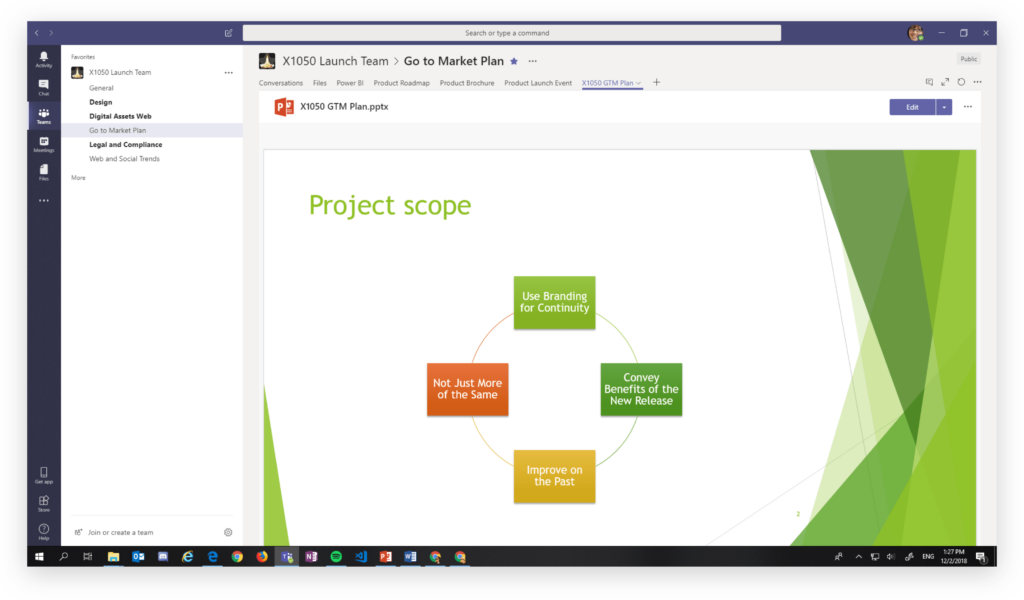
The quickest way to ask others for feedback is to open the chat window on the right and start a new conversation.

If you're using @channel mentions, only people in this channel will receive the notification. You can also use the @team feature and everyone on your team will receive the notification. Choose mentions wisely.
After posting the message, your colleague Joni responds:

That's the power of Teams when you're using it: no emails, just a simple chat with all the modern features you'd expect:
- Possibility to like
- @mentions
- Emojis
- GIFs
- Editable stickers
In addition, the chat window has an advanced editor, which gives you quite a lot of formatting options.

Your team members can open the presentation in Teams, Office Online, or even through the desktop app, and editing is available in all versions. You can also use Microsoft 365's built-in chat feature to discuss feedback in real time.
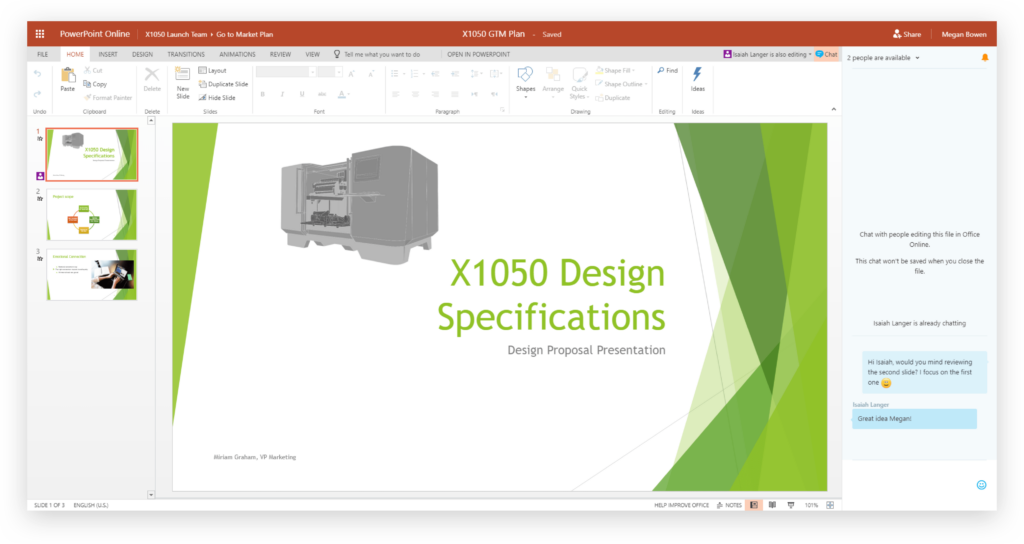
This solution prevents potential content issues and sets clear expectations. Suddenly, one of the team members posts an interesting comment:
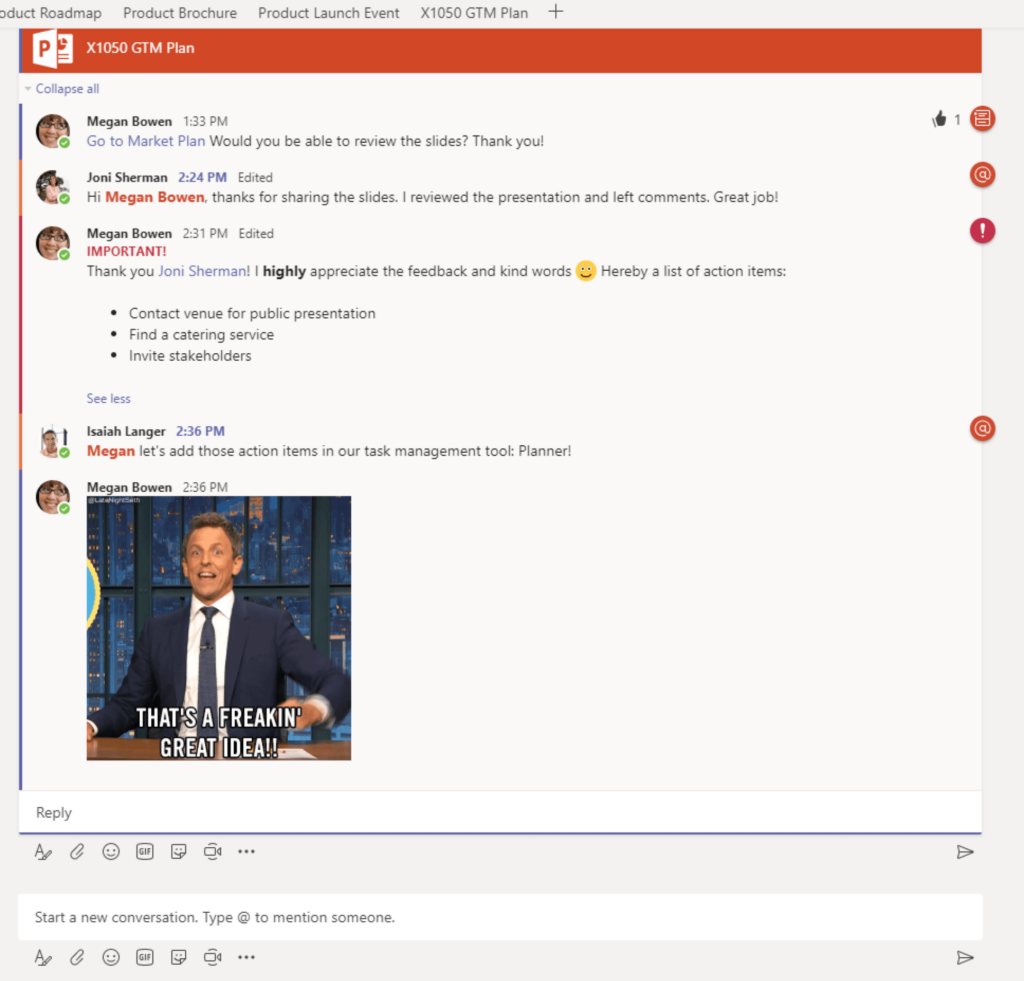
Microsoft Teams is in Planner
Planner! This lightweight task management tool is a standalone service in Microsoft365, but tightly integrated with Teams. When you start a new channel, you can immediately connect a Planner tab to it:

You can also quickly assign tasks to the right team member:
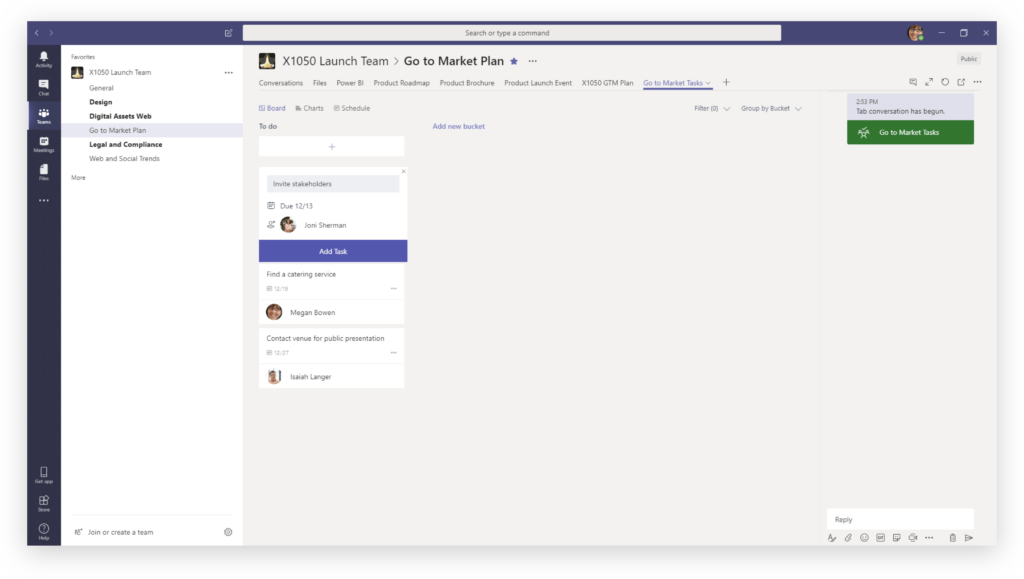
Planner also allows you to assign files to tasks:

The team member assigned to the task now knows which file—in this case, the presentation—to use for their task. Note: you can't upload files from the Teams tab, this is only possible in the standalone Planner.
Schedule a meeting in Microsoft Teams
Let's go back to Teams. Once others have given their opinion on your presentation, you're ready to present your final version. Teams is connected to Outlook, so you can create a meeting here:
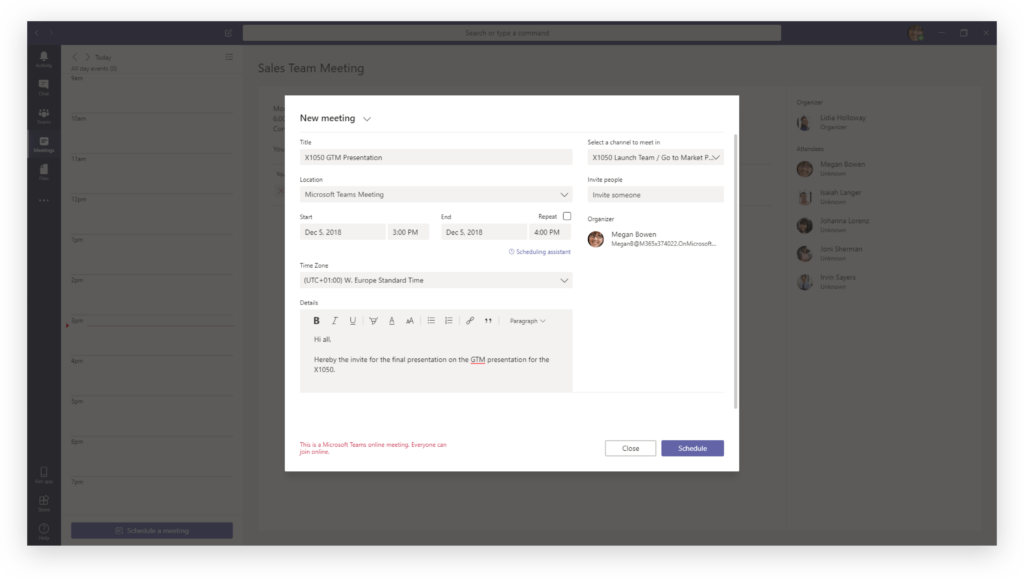
Select a channel for the meeting to choose which channel you want the meeting to be held on. If the meeting is scheduled, it will also be visible in the channel's feed.

The meeting is automatically added to your calendar because you're the organizer. Other participants, on the other hand, will have to do this manually. There will be a clickable option in the event details. Easy! Since the meeting was created in Teams, it will also be held here:

Work with outsiders in Microsoft Teams
After finalizing the presentation internally, it became clear that you would need to work with an external marketing company, Easterfield, to help you implement the X1050.
Unfortunately, the files themselves cannot be shared. Therefore, you need to send an invitation to external users, who in turn will have access to the entire Teams channel. Unfortunately, this is not the most ideal solution in many cases. In the next part of this series, we will look at what you can do with such situations in SharePoint as an alternative solution.
The external contact who has previously used Teams will see the following interface:

In my own experience, it is very difficult to always know everything when you have to work with several external partners. I suggest that you ask others to use the @mention feature for important questions and topics to make sure you receive notifications.
For external partners, there are a few basic settings available. Microsoft has collected and documented these particularly. (You can view it here)
For guests to work in the team, the appropriate options must be activated. If you can't invite guests, contact your Microsoft 365 admin. His role is very important in external sharing in Microsoft 365 and Teams, so you should always include him in your plans if you're going to do so.
Control content collaboration in Teams
Teams is inherently difficult to set up because it's also connected to Microsoft 365 groups. That is, when you create a new Teams team, you create another one along with it:
- Exchange Online mailbox and calendar. Automatically, they do not appear in Outlook. To access them, open Conversations on the group's SharePoint page.
- SharePoint Online Group page,
- OneNote notebook
- PowerBI workspace
- Stream group. This may take some time to create and will not be immediately available.
A management strategy is therefore essential to manage the effects of the modern workplace. Be absolutely sure that your strategy covers the following areas.
- Creation process
- Naming rules
- Expiration rules
- "Soft" wipe and restore
- Rules and information protection
- Guest access
- Reporting
The file part of Teams allows you to connect to external cloud storage (e.g. Dropbox). If this option isn't turned off, you won't have any visibility into what content has left your Microsoft 365 environment. In the previous section, we talked about OneDrive. We also looked at various related security features, data classification, mobile device management and mobile application management. Of course, this advice also applies to Teams.

Introduction to Teams and Training
Teams is designed for business users. User-friendly design and integration with other Microsoft 365 services help new users quickly and easily navigate the first time they use it. Now that I've written this, the introduction is vital. You can't just demo Teams and leave a team of users with it and wish them success. Explain how Teams can integrate into your daily workflows. Remember that no matter how great technology can be, if it doesn't have any clear business value, it won't succeed. My advice is to talk to people during the introduction, who care about being able to work together. Collect expectations and compare them to features in Teams. Show how Teams works with real-life examples so end users can seethe value right away. When the organization wants to continue to grow, training must be provided to ensure that the implementation is successful.
Microsoft has collected a lot of content on this topic. I think it's worth starting here:
Microsoft Teams and OneDrive are the duo that's made in heaven
Teams is an intuitive, easy-to-use tool that's ideal for collaborating on content within a department or team. That's why I fell in love with Teams right from the start. Integration with OneDrive allows users to start working in a private environment and easily move them to social storage when they're ready to collaborate with everyone on the team. This is the kind of cooperation that the modern world needs!
In the next section, I'm going to look at SharePoint collaboration, stay tuned!





